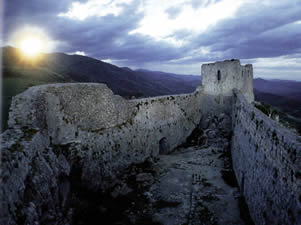The Slaughters of Béziers
The crusader army came under the command, both spiritual and military, of the papal legate Arnaud-Amaury, Abbot of Cîteaux. In the first significant engagement of the war, the town of Béziers was besieged on 22 July 1209. The Catholic inhabitants of the city were granted the freedom to leave unharmed, but many refused and opted to stay and fight alongside the Cathars. The Béziers army attempted a sortie but was quickly defeated, then pursued by the crusaders back through the gates and into the city. Arnaud, the Cistercian abbot-commander, is supposed to have been asked how to tell Cathars from Catholics. His reply, recalled by Caesar of Heisterbach, a fellow Cistercian, several hundred years later was "Caedite eos. Novit enim Dominus qui sunt eius." — "Kill them all, the Lord will recognise His own." The doors of the church of St Mary Magdalene were broken down and the refugees dragged out and slaughtered. Reportedly, 7,000 people died there including many women and children. Elsewhere in the town many more thousands were mutilated and killed. Prisoners were blinded, dragged behind horses, and used for target practice. What remained of the city was razed by fire. Arnaud wrote to Pope Innocent III, "Today your Holiness, twenty thousand heretics were put to the sword, regardless of rank, age, or sex." The permanent population of Béziers at that time was then probably no more than 5,000, but local refugees seeking shelter within the city walls could conceivably have increased the number to 20,000.
The Fall of Montségur
From May 1243 to March 1244, the Cathar fortress of Montségur was besieged by the troops of the seneschal of Carcassonne and the archbishop of Narbonne. On March 16, 1244, a large and symbolically important massacre took place, where over 200 Cathar perfects were burned in an enormous fire at the prat des cramats near the foot of the castle


